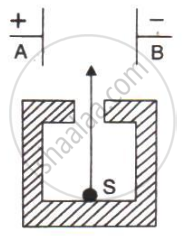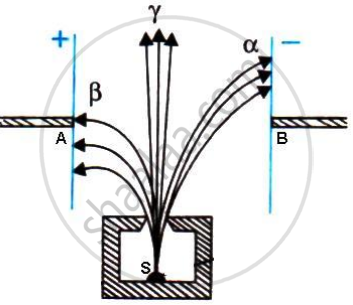Advertisements
Advertisements
प्रश्न
In following Figure shows a radioactive source S in a thick lead walled container having a narrow opening. The radiations pass through an electric field between the plates A and B.

- Complete the diagram to show the paths of α, β and γ radiations.
- Why is the source S kept in a thick lead walled container with a narrow opening?
- Name the radiation which is unaffected by the electrostatic field.
- Which radiation is defleced the most. Given reason.
- Which among the three radiations causes the least biological damage?
उत्तर

- The radioactive substances are kept in thick lead containers with a very narrow opening, so as to stop radiations coming out from other directions because they may cause biological damage.
- Gamma radiations.
- Beta radiation (β) is the lighter of the two types of radiation, C and A, which are alpha radiation (α).
- Alpha particle.
APPEARS IN
संबंधित प्रश्न
State following four properties each of α, β and γ radiations:
- Nature,
- Charge,
- Mass and
- Effect of electric field.
Arrange the α, β, and γ raditions in ascending order of their ionising powers.
State the speed of each of α, β and γ radiations.
Arrange the α, β, and γ radiation in ascending order of their biological damage. Give reason.
Compare the penetrating powers of α, β and γ-radiations.
Compare the ionising powers of α, β and γ radiations.
What are α-and β-radiations?
A beam of α, β and γ rays is travelling through a certain region in space.
- Arrange them in ascending order of ionising power.
- Which of the above will pass undeviated if subjected to an electric field?
- With respect to your answer to part (b) above, what will be the change in the nucleus of an atom after such a ray is emitted.
Which nuclear radiation will travel undeviated in an electric field?
Which of the following radiations suffer maximum deflection in a magnetic field?
